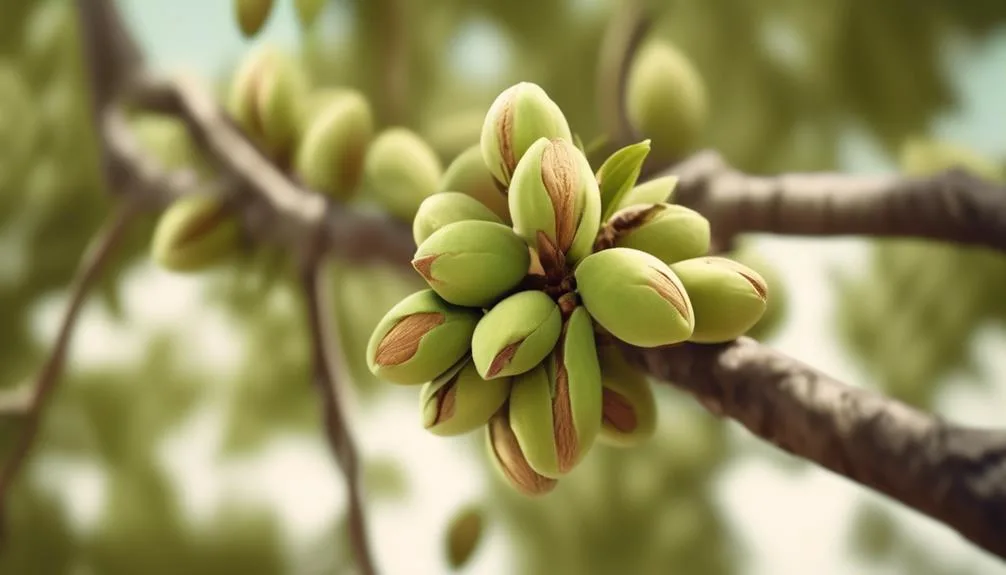Ever wondered why almond trees have tough shells around their seeds?
The reason behind this lies in the complex biological processes of the almond tree. By understanding the tree's growth cycle and environmental adaptations, we can uncover the fascinating reasons for the development of these essential shells.
Key Takeaways
- Almond shells serve the purpose of protecting the delicate kernels from environmental elements and pests.
- Shell development begins as the almond fruit matures, with the outer hull hardening to form a protective layer.
- Almond trees are adaptable to various climates and soil conditions, allowing them to thrive in diverse environments.
- Proper pruning and pollination are crucial for successful almond tree growth, ensuring strong branches and a bountiful harvest.
Almond Tree Growth Process
As almond trees grow, they progress through distinct stages, each essential for the development of their delicious and nutritious nuts.
Almond tree pollination is a crucial step in this process. Bees play a vital role in pollinating almond trees, transferring pollen from one blossom to another, allowing the trees to produce almonds.
Pruning is another integral aspect of almond tree growth. Proper pruning helps in maintaining tree health, improving sunlight exposure, and ensuring better air circulation. It also encourages the development of strong, healthy branches and facilitates easier harvesting.
By understanding and managing these growth processes, almond tree farmers can ensure a bountiful harvest of high-quality almonds.
Formation of Almond Shells
After experiencing the intricate growth process of almond trees, you may wonder about the fascinating formation of almond shells and the role they play in protecting the nutritious nuts within. The development of almond shells is crucial for safeguarding the delicate kernels. Genetic factors significantly influence the thickness of the shells, determining the level of protection provided to the almonds. The process of shell development begins as the almond fruit reaches maturity, with the outer hull hardening to form a protective layer around the nut. This natural armor shields the nut from environmental elements and pests, ensuring its integrity until harvest. The table below illustrates the key factors influencing the formation of almond shells, shedding light on the intricate process that safeguards the valuable nuts.
| Factors | Influence on Shell Formation |
|---|---|
| Genetic Factors | Determines shell thickness |
| Environmental | Conditions impact development |
| Nutritional Intake | Affects shell strength |
Purpose of Hard Almond Shells
The hard shells of almonds serve as a protective barrier, preserving the delicate kernels from environmental threats and ensuring their viability for consumption. These shells shield the nutritious almond inside from pests, moisture, and physical damage, safeguarding its quality and integrity.
Additionally, the hard outer layer functions as a means of nutrition storage, keeping the almond kernel safe and intact until it's ready to germinate. This protective enclosure also plays a crucial role in maintaining the almond's freshness and preventing rancidity, thus prolonging its shelf life.
The tough exterior not only defends the almond from external elements but also helps to maintain its nutritional value, making it a reliable source of essential nutrients.
Therefore, the hard shells of almonds serve a dual purpose of protection and nutrition storage, ensuring the almond's quality and edibility.
Environmental Adaptations
Almond trees have developed remarkable environmental adaptations to thrive in diverse climates and conditions, ensuring their continued growth and production of nutritious almonds.
These trees exhibit impressive climate tolerance, being able to flourish in Mediterranean-type climates with mild, wet winters and hot, dry summers.
They've also adapted to a variety of soil requirements, including well-draining, deep soils with a pH between 6.0 and 8.0.
To counter natural predators, almond trees have evolved protective mechanisms, such as producing chemical compounds that deter pests.
Furthermore, their pollination process involves a fascinating adaptation where the flowers require cross-pollination from other almond varieties to produce a successful yield.
These environmental adaptations are crucial for the sustainability of almond trees and their valuable almond production.
Harvesting and Processing Almonds
Harvesting and processing almonds involves meticulous attention to timing and technique to ensure the preservation of their delicate flavor and quality. When it's time to harvest almonds, the outer hulls are removed, and then the almonds are dried to a specific moisture level.
After drying, the almonds undergo a process called hulling, where the hulls are removed to reveal the hard shell protecting the kernel. Almond shell removal is a critical step, as it allows access to the prized almond kernel inside.
Next, the almonds are processed to extract the kernels. This delicate almond kernel extraction process requires precision to avoid damaging the kernels.
Once extracted, the almonds are ready for consumption or further processing into various almond products.
Conclusion
In nature, the almond tree's hard shells serve as a crucial defense mechanism, ensuring the protection and survival of its seeds. This adaptation not only safeguards the almond, but also reflects the intricate balance of environmental factors and evolutionary processes.
The resilience of these shells prompts us to ponder the remarkable ways in which plants have adapted to thrive in their ecosystems. As we savor the delicious nut within, we can appreciate the intricate journey that led to its creation, reminding us of the wonders of the natural world.

